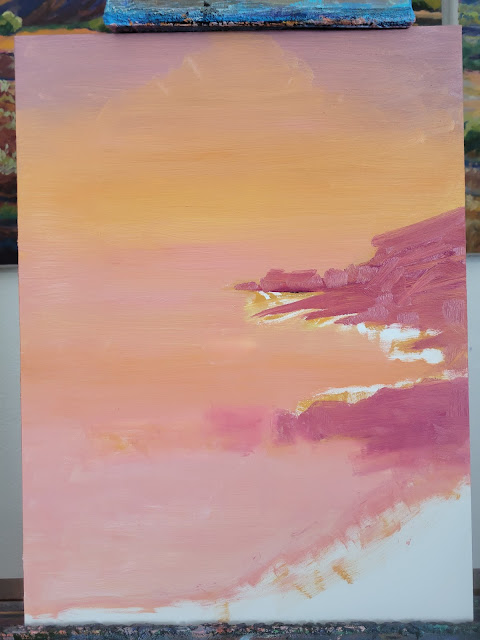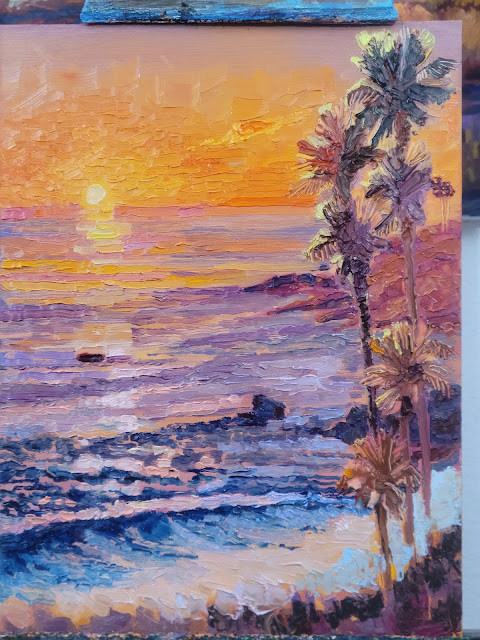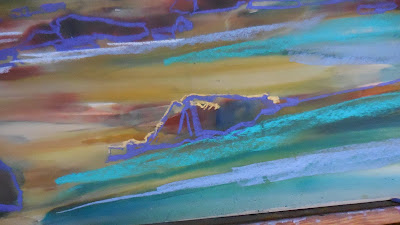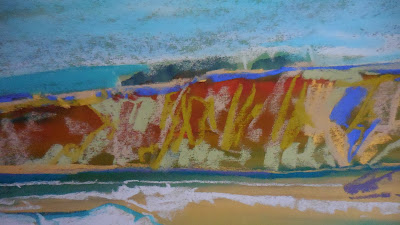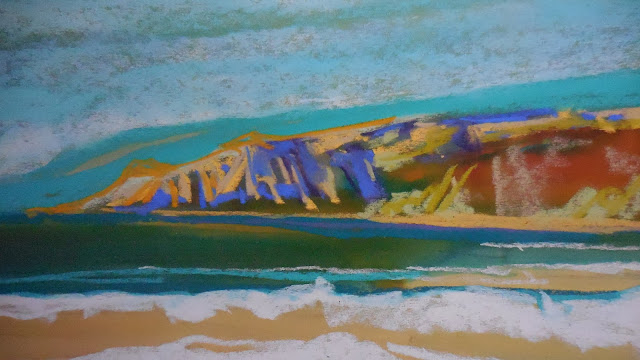As a painter, I have tried to further my understanding of my technique and my process. I have evaluated thousands of paintings. Many of these evaluated paintings were the paintings of others. In breaking down these paintings, my objective has been to try and understand what was done and how it was done. After analyzing my paintings I wanted to understand and describe the abstraction within my painting.
There has been a lot of discussion by artists about abstraction within their painting. I am sure there are a great number of similarities between the artist's processes. Here I am taking the time to dive into my process, techniques, ideas, thoughts, and origins of abstract elements within my landscape painting.
For a brief period, I experimented as a abstract painter. I used it as a way to further my skill. I worked out color, composition, and mark making issues. The freedom of nonrepresentational painting removed the stigma of accuracy and realism from my efforts. Abstract painting allowed me to express ideas that would not neatly fit within my more conventional painting efforts. It also was a very direct way to convey emotions within my painting. In fact, the expression of emotion was often the real subject matter of these paintings.
Plein air painting has been instrumental in my furtherance of abstraction within my landscape painting. I generally paint large pieces outdoors. I always complete these paintings in one session. These sessions may last anywhere from 3 to 5 hours. The efficiency and speed with which I paint is dependent on my ability to break down the landscape visually. Seeing things as a number of small pieces and colors that connect and relate to each other, enables me to see abstractly. Yes it is a seascape or landscape but it is made up of these gestural marks, colors, values, and shapes which are intended to represent the whole. When taken independently they represent nothing but themselves.
Conceptual Abstraction may be made by filtering the information content of a concept or an observable phenomenon; selecting only the aspects which are relevant for a particular subjectively valued purpose. When confronted with millions of details the question is what do you include and how do you include the most important elements. The intent is not to create abstract paintings but rather how to create representational paintings free from the burden of descriptive detail.
I am constantly reminded to simplify by other artists. The detail of the landscape is what is intriguing to me. The question is not how to simplify but rather how do I represent the impossible detail before me.
It is impossible to paint all of the detail before me. My objective is to translate what I am seeing and feeling into a credible representation of the beauty before me.
The feeling of freedom is critical to the success of a painting. When I speak of freedom I am speaking about the ability to create with a minimum of preconceived ideas about how something is supposed to look. Reacting to what is in front of me is at it's best spontaneous.

When I am painting, there is no time for reflection. It is like playing a sport. There are objectives and strategies that I want to achieve. As I am painting, the decisions for the most part are subconscious. I am reacting to what is in front of me and to what I am doing on the surface in front of me. All of the practice and the time you have put in make it possible to remain in the zone without overthinking it. It is like walking down an invisible path that reveals itself before you as you move forward. It is not as if I feel constrained by the path. It is there but it isn't restrictive. It can go in many directions. There is no fear of what the next step is. The momentum of the process takes you forward. The overall feeling with which I relate to the subject washes over the entire effort and influences the outcome when things are going well.




One of my ideas about abstraction is what I call Contextual Abstraction. When painting a landscape there are areas of the painting that when removed from the context of the overall painting become unrecognizable. The way I see the subject allows me to observe something out of its contextual reality. I reduce the complex detail of the landscape to shape, color, value, and pattern. I then replicate it my own way through my mark making. When you remove the context from the subject of the painting, the possibilities for abstraction open up to the artist.
Before you paint it you see it. In order to paint it my mind must be free to express and interpret what I am seeing. The expression of a 3D scene onto a 2D surface is itself a abstract process. My visual explanation is the summary essence of the thing I am painting. This essence is my abbreviation of what I am seeing. This abbreviation is expressed through my visual shorthand. This shorthand is made up of my mark making. My mark making process particularly when I am painting with pastel, embodies value, color, gesture, and shape all at the same time. The immediacy of choice with pastels as a medium furthers the spontaneity within the painting.
A rock. It is made up of twenty colors? It is made up of how many shape / values?
When observing the landscape that I am about to paint, I try to see the whole thing at the same time. What I am trying to do is to see patterns, colors, values, and shapes that summarize a large amount of the landscape. Seeing the same color and where it shows up throughout composition frees up my expression by speeding up the decision making process. When you put these colors, shapes, patterns, and values down without anchoring them to the syntax within the painting frees your attention to detail and opens you up to symbolic abbreviation-abstraction. It in time becomes the syntax of the painting as the main objects emerge from the painting.
The abbreviation of detail within the landscape revolves around the ability to summarize the essence and convey that detail in an efficient and effective manner. This is where the experience and the miles of painting come into play. Those miles of painting lead you to trust your observations, the confidence to express, and the development of your visual language. Over time we each develop our own personal visual language. This in turn becomes a symbolic expression through our mark making. Our experience and practice leads to a personal shorthand that allows us summarize and abbreviate large amounts of information in a personal and idiosyncratic method.
Confidence in your ability is critical to abstraction. You must be able to trust yourself enough to let go of the idea of success or failure. It is a distraction that pulls you out of your reality in the moment. When you are thinking about the future of your effort or the past painting efforts you are pulled out of the zone and flow of execution. Abstract mark making comes from the freedom of the subconscious being given permission to be the moderator of the painting. Thinking breaks the process whereby subconscious expression is allowed to percolate to the surface. Thinking is what you do when you have a problem that needs to be solved. Painting is what you do when you know the answers. Growth comes from problem solving that results in clean execution. The problem solving should occur before you put brush to canvas. Losing your way is what happens when you don't have the conviction to stick to your initial thoughts and purposes or your skills do not match your intention.
Conceptual Abstraction may be made by filtering the information content of a concept or an observable phenomenon; selecting only the aspects which are relevant for a particular subjectively valued purpose. When confronted with millions of details the question is what do you include and how do you include the most important elements. The intent is not to create abstract paintings but rather how to create representational paintings free from the burden of descriptive detail.
Abstract art is art that does not attempt to represent an accurate depiction of a visual reality; but instead, uses shapes, colors, forms, and gestural marks to achieve its effect.
-Wassily Kandinsky


